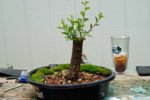@KiwiPlantGuy Hose Clamps have to be watched more, I'm not a....fan....of the straight line it will give you if left too long...
"Insta-ugly gonna get you".
It's way safer to use parafilm, and electircal tape...something with more give, that you can progressively wrap up in overlays, like a baseball bat grip. So there is never one straight line of pressure....
By adjusting the tightness of the wrap, and the number of layers, you can successfully create a scenario where it is impossible for it to get ugly. Of course this is near impossible, but the goal.
Further, if many layers are used....
After a while you can begin cutting some layers (carefully, pulling with tweezers and slicing with a steady hand) from the outside, but leaving it in place...this allows a further "fine tuning" without need for complete removal. Lessening pressure in small increments, in strategic places.
For example, the extra tight wrap you must begin and end with to get it to stay at first...those are the first to be cut and loosened. After which pressure should be quite equal, except for where the film may have doubled over on itself...those areas should have the second most heavy pressure, and would be cut next.
Speaking of pressure....(shoot selection)
This growth...to me...is like the water that comes out of a hose that has been turned off, and is being rolled up.
The amount of stored energy in the tree is equal to the amount of water left in the hose. Imagine a tree that was just 3m tall and fully healthy...a full hose.
While a tree that was in a bonsai pot and kept smaller has only about 20% full.
The idea is to utilize this energy reserve properly before it runs out, to properly space our kept shoots around the ring.
With a hose, we can use forethought, and screw a rosette on the end before we wrap it up, so the energy is equally divided and comes out perfect.
So, how to "screw a rosette" to the top of these brooms?
People get scared to shoot select, but with a proper gauge of stored energy, and a plan to protect what you keep, even if it means building a cage for this to sit in...
While we may not be able to create a perfectly balanced even rosette....making well calculated attempts to utilize this stored energy to the best end is what we must do.
There is risk. But a man who must eat takes risk in selecting one of 2 vegetable seedlings. He discards one in his confidence in the other. At risk of starvation.
I will be so confident with my art, because for me, risking artistic failure is worse than starvation! (Note that shit!)
So have confidence.
In a perfect world you end up with equally healthy shoots all the way around.
John's result is more typical ..
For me, it becomes a mission of balancing vigor and position. (Screwing that rosette on before the energy runs out)
This tree had a lot of energy, so I personally wouldn't be afraid to continue stomping out a few shoots on that vigorous side, definitely the big ones, in an effort to get some of that energy popping on the close side, before it runs out.
Even the worst tuned Future Vision Goggles know small shoots so clustered are going to battle for dominance, and eventually, some will die. Thing is they die before giving anything back to the tree...so keeping them is ONLY bad.
I argue the faster you get to knocking them out, the better.
Hose theory says if those 2-3 extra vigorous shoots were stomped out as soon as they were identified as too dominant, the close side may be further along.
We are simply guiding the tree to what it wants to be anyway, even, perfect.
To me, those little shoots in the front, is the tree saying, "hey asshole, why didn't you tell me this was a great place to grow?"
Sorry tree, next time I will do better!
"But wait Sorce....you Kill ULMUS regularly...
Surely we can't take advice from someone who kills ULMUS regularly, you don't have any nice finished trees so you must be wrong...."
I've utilized this method (or the theory behind it) successfully to the point where the shoots were into an energy giving state which is proof that it works and is not the reason I have been killing these.
I have been killing these which is proof this works with trees that aren't even healthy.
Which means Damn near anyone can use this method with more confidence than I, to a better aesthetic end, which I assume is what we are going for.
Sorce







